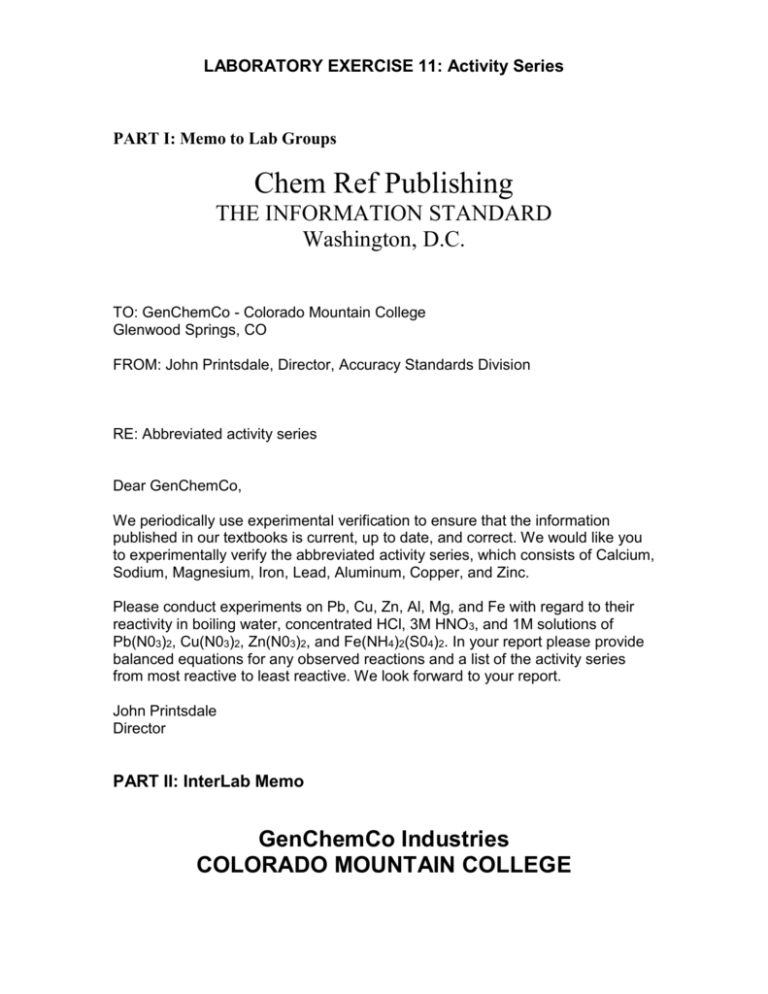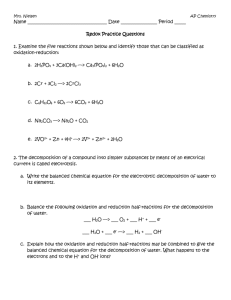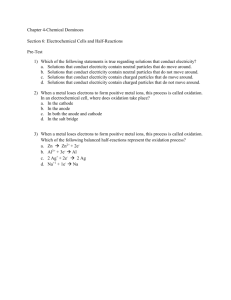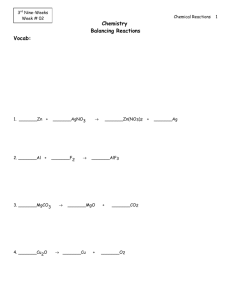
LABORATORY EXERCISE 11: Activity Series
PART I: Memo to Lab Groups
Chem Ref Publishing
THE INFORMATION STANDARD
Washington, D.C.
TO: GenChemCo - Colorado Mountain College
Glenwood Springs, CO
FROM: John Printsdale, Director, Accuracy Standards Division
RE: Abbreviated activity series
Dear GenChemCo,
We periodically use experimental verification to ensure that the information
published in our textbooks is current, up to date, and correct. We would like you
to experimentally verify the abbreviated activity series, which consists of Calcium,
Sodium, Magnesium, Iron, Lead, Aluminum, Copper, and Zinc.
Please conduct experiments on Pb, Cu, Zn, Al, Mg, and Fe with regard to their
reactivity in boiling water, concentrated HCl, 3M HNO3, and 1M solutions of
Pb(N03)2, Cu(N03)2, Zn(N03)2, and Fe(NH4)2(S04)2. In your report please provide
balanced equations for any observed reactions and a list of the activity series
from most reactive to least reactive. We look forward to your report.
John Printsdale
Director
PART II: InterLab Memo
GenChemCo Industries
COLORADO MOUNTAIN COLLEGE
InterLab Memo:
As you can see from the attached letter, our group was asked to experimentally
verify the abbreviated activity series.
I would like the class to brainstorm on the best techniques to apply to gather
experimental data, and also to try to predict the order of activity for the metals in
advance of any data gathering. Each group will perform experiments on two of
the metals, and the class as a whole will observe the tests on Sodium and
Calcium.
Each group will submit a report to me, due two weeks from today, which should
include the following sections:
1. INITIAL WORKING HYPOTHESIS
2. INITIAL WORKING PLAN
3. DATA AND OBSERVATIONS: Please show any measurements or
observations, along with any calculations you make.
4. ANALYSIS OF THE DATA: Does the data support your hypothesis? Why?
Why not?
5. FURTHER STEPS TAKEN: Please include any steps taken beyond your initial
working plan, the reasons for those actions, and the results.
6. A LETTER OF RESPONSE: Each group should submit a response directed to
the client outlining what you did, what you found, and how this addresses the
client's request.
PART III: INSTRUCTIONS
1. Any element in the "free" state (not combined with any other element) has an
oxidation number of zero, regardless of the complexity of the molecule in which it
occurs. Each atom in Ne, O2, P4, and S8 has an oxidation number of zero.
2. The oxidation number of any ion (monoatomic or polyatomic) equals the
charge on the ion. The Ca2+, NH4+, S2-; and PO4-ions have oxidation numbers of
2+, 1+, 2-; and 3- respectively.
3. Oxygen has an oxidation number of 2- (except 1- in peroxides, e.g., H2O2, and
2+ in 0F2). The oxidation number of oxygen is 2- in KMnO4, Fe2O3, CaO, and N20.
4. Hydrogen has an oxidation number of 1+ (except 1- in metal hydrides, e.g.,
NaH or CaH2). Its oxidation number is 1+ in HCl, NaHCO3, and NH3.
5. Some elements exhibit only one oxidation number in certain compounds.
a. Group IA elements (U, Na, K, Rb, and Cs) always have a 1+ oxidation number
in compounds.
b. Group IIA elements (Be, Mg, Ca, Sr, and Ba) always have a 2 + oxidation
number in compounds.
c. Boron and aluminum always possess a 3+ oxidation number in compounds.
d. Group VIA elements (0,S, Se, and Te) exhibit a 2- oxidation number in all
binary compounds with metals.
e. Group VIIA elements (F, Cl, Br, and I) exhibit a 1- oxidation number in all
binary compounds with metals.
6. The oxidation number of any other element does not follow set rules, it may
vary depending upon the elements with which it combined to form the compound.
Generally one or more of the elements in a compound follow Rules 1-5; since the
compound must be neutral, the oxidation number of the element in question can
be calculated.
Example 1. What is the oxidation number of Fe in Fe2O3?
Since each oxygen is known to have a 2- oxidation number (for a total of 6- and
the sum of the oxidation numbers of Fe2O3 is zero, the combined oxidation
numbers of the two iron atoms must be 6+, or each Fe atom must be 3+.
7. The oxidation number of polyatomic ions is the charge of the ion (see Rule 2).
The oxidation numbers of the constituent atoms in the ion are determined as in
Rule 6.
Example 2. What is the oxidation number of Cr in the dichromate ion, Cr2O7 2-?
Each oxygen has a 2- oxidation number (for a total of 14-) and the oxidation
number of Cr2O7 2- is 2-. Since 2Cr + 14- = 2-, the combined oxidation number of
the two chromium atoms must be 12+, or each Cr atom is 6+.
Additional practice questions are available in your text book.
The relative tendency for a metal to acquire a positive oxidation number by losing
valence electrons (referred to as its chemical activity) is measured in this
experiment. The metals listed in order of decreasing activity comprise an
abbreviated activity series.
Metal and Water - Rate of Hydrogen Gas Evolution:
Very reactive metals are oxidized by water resulting in the evolution of H 2 gas
and heat.
oxidation: M(s) --> Mn+(aq) + n ereduction: 2 H2O (l) + 2 e- --> 2 OH-(aq) + H2(g)
The rate of evolution of H2 gas is not an absolute criterion of the chemical activity
of the metal because the reaction involves several variables, e.g., particle size of
a metal. It is, however, a qualitative method for observing reactivity.
Metal and Hot Water - Rate of Disappearance of Metal:
Less active metals in hot water cause a similar reaction to occur. The rate of
evolution of H2 gas is often so slow that the rate of disappearance of the metal is
used as the measure of activity, even though the particle size of the metal does
influence the reaction rate.
Metal and Nonoxidizing Acid - Rate of Hydrogen Gas Evolution:
By comparison, some metals evolve H2 gas only with the addition of a
nonoxidizing acid, such as HCl(aq) or H2SO4(aq). The metal is oxidized and the
H+ is reduced.
oxidation: M(s) --> Mn+(aq) + n ereduction: 2 H+(aq) + 2 e- --> H2 (g)
Metal and Oxidizing Acid - Rate of Gas Evolution:
Metals that can only be oxidized by an oxidizing acid have a very low activity.
Common oxidizing acids include nitric acid, HN03(aq), and perchloric add,
HClO4(aq). For conc nitric add, the reactions are:
oxidation: M(s) --> Mn+(aq) + n ereduction: 2 H+(aq) + NO3-(aq) + e- --> NO2 (g) + H20(l)
Metal and More Reactive Metal Cation - A Displacement Reaction
The activity one metal relative to another can be determined by placing the metal
into a solution containing the cation of the other. If metal M is more active (a
greater tendency to be oxidized) than metal R, then M will displace Rn+ from the
aqueous solution. M goes into solution as Mn+ and Rn+ forms the metal, R.
M(s) + Rn+(aq) --> Mn+(aq) + R(s)
For example, when iron wire is placed in a lead(II) solution, a reaction occurs
because the iron is more active than lead, causing the formation of Fe2+ and the
reduction of Pb2+ to Pb metal.
oxidation: Fe(s) --> Fe2+(aq) + 2 ereduction: Pb2+(aq) + 2 e- --> Pb(s)
On the other hand, when a lead strip is placed in an iron(II) solution, no reaction
occurs because lead metal is less active than iron and is incapable of displacing
the iron(II) ion from solution:
Pb(s) + Fe2+ (aq) --> no reaction
B. Metal and Hot Water - Rate of Disappearance of Metal
1. Pb, Cu, Zn, Fe, Al, and Mg. Thoroughly clean a 2 cm strip of each metal with
steel wool to remove any oxide coating. This is especially critical for Al and Mg
since they form tough, protective oxide coatings (the dull finish on a metal
caused by its reaction with the oxygen in air.) Obtain a 24-well plate, rinse six
microcells with boiling, distilled (or deionized) water, and then half-fill with boiling
water; add 1 drop of phenolphthalein to each cell.
2. Quickly place each metal into the microcells, Al and Mg first (see Figure
below). Look for H2(g) evolution, discoloration of the metal surface, a color
change of the solution (due to the phenolphthalein), or a disappearance of the
metal. Some reactions may not be immediately apparent. Record your
observations.
C. Metal and Nonoxidizing Acid - Rate of Hydrogen Gas Evolution
1. Add 5 drops of conc HCl (Caution: avoid skin contact) to the metals from Part
B in which no reaction was observed. Swirl the solutions; allow 10- 15 minutes
for evidence of a reaction. Record.
D. Metal and Oxidizing Acid - Rate of Gas Evolution
1. If a metal shows no reaction in Parts B or C, draw off the water/acid solution
with a Beral pipet and discard it. Add I mL of 3 M HNO3 (Caution: avoid skin
contact). If a reaction is now observed, record your observation.
E. Metal and More Reactive Metal Cation - A Displacement Reaction
1. Pb, Cu, Zn, and Fe. Place a small amount of a freshly cleaned metal in four
consecutive microcells of the 24-well plate-one metal in each microcell. Half-fill
each microcell with 0.1 M Pb(N03)2. Any tarnishing or dulling of the metal or
changing of the color of the solution indicates a reaction. Allow 5-10 minutes for a
reaction to be observed.
2. Repeat the procedure, using the following 0.1 M test solutions on each metal:
Cu(N03)2, Zn(N03)2, and Fe(NH4)2(S04)2. In each case the same metal strip may
be reused if it remains unreacted from the previous test, rinsed with distilled
water, and cleaned with steel wool. Record.
F. Establishment of Activity Series
Using the observations from Parts A through F, list the eight metals in order of
decreasing activity.
Disposal Information:
Dispose of the metals in the "Waste Solids" container and the solutions in the
"Waste Salt Solution" container.
All contents copyrighted (c) 1998
Peter Jeschofnig, Ph.D., Professor of Science, Colorado Mountain College
All Rights reserved









